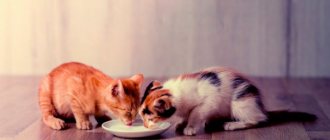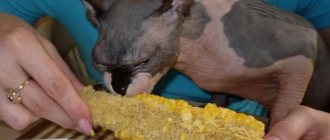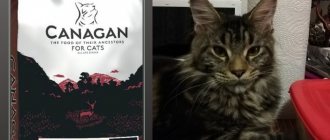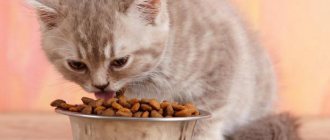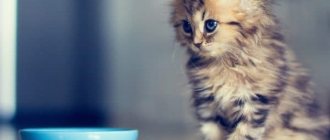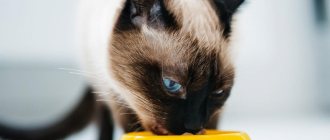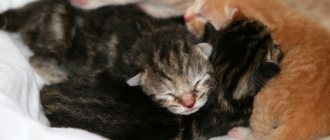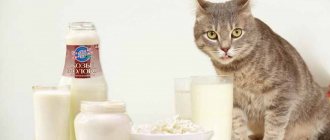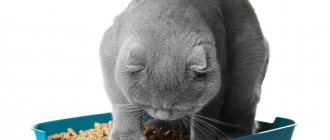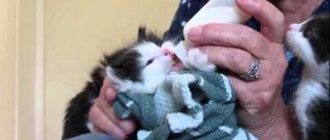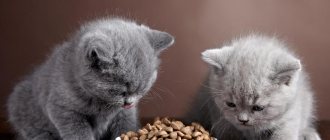The main principles of proper feeding
To feed Sphinxes, you can use both dry and wet food. But regardless of the type chosen, you must remember the following rules:
- The cat should receive a strictly dosed portion. This breed is prone to overeating.
- When choosing a diet, age must be taken into account. Kittens, adult pets, pregnant females and older cats have their own feeding habits.
- Compliance with the regime. The Sphinx must receive food at the same time. In this case, you don’t have to worry about the digestion process, since these cats often suffer from stomach pain.
Thanks to their accelerated metabolism, Sphinxes have an excellent appetite and sometimes eat completely non-cat foods.
This is the Canadian Sphynx
Industrial feed
The requirements for feeding pets with prepared food - dry or wet - are standard. This:
- Strict adherence to the daily norm. Manufacturers always indicate the serving size on the packaging.
- When choosing food, you need to take into account the age of the Sphinx. For kittens, adult pets, pregnant, spayed/sterilized and elderly cats, we offer our own food that takes into account their age needs.
- Free access to clean water when dry feeding. If the cat drinks little, then forced supplementation or transfer to another type of food is necessary.
It is strictly forbidden for Sphynx cats to be given food below the premium level. In cheap formulations, the source of protein is soy, wheat and corn, but plant proteins are practically not absorbed by the cat’s body. The share of meat components is minimal and of poor quality. As a rule, fat, feathers and offal are used in production.
Natural products
When choosing the option of feeding “natural”, you need to ensure that the nutrition is completely balanced. The cat's menu should include the following products:
- beef and veal;
- chicken offal – neck, heart, gizzards, liver;
- seafood, turkey, chicken - raw;
- steamed fish (cod, salmon);
- boiled egg yolk;
- fermented milk products – cottage cheese, yogurt and others;
- cereals;
- cereals – buckwheat, rice;
- vegetables fruits.
You need to remove all the bones from the fish and grind the meat in a meat grinder.
Recommendations for creating a menu for the week:
- well-frozen and scalded raw beef/veal – daily;
- boiled chicken – up to 4 times;
- boiled/frozen offal - no more than three times;
- porridge (from rice, buckwheat, oatmeal and wheat) - up to three times;
- vegetables, fruits (fresh, boiled) - up to three times;
- sour milk, cheeses – 1 time;
- heat-treated sea fish fillet, egg yolk.
It is recommended to season ready-made dishes with a small amount of vegetable oil, but adding salt or sweetening food is prohibited. In addition, food should be at room temperature.
Vitamin and mineral supplements
If industrially produced food is used to feed the Sphinx, then no additives need to be introduced.
When feeding “natural” food, you must add:
- brewer's yeast - they are suppliers of B vitamins;
- ready-made mineral supplements, for example, Kizim.
The dosage of yeast should be calculated by a veterinarian based on the weight of the cat.
Graceful kitty
What food to choose for your Sphynx
Food for Sphynxes should only be premium, super premium and holistic.
Premium dry food:
Super premium food:
Almost all brands produce dry food specifically for elderly, pregnant cats, castrates, kittens, animals leading a sedentary lifestyle, and medicinal ones. Wet food is also divided into classes; it can be medicinal and dietary.
For example, Royal Canine produces specially dry food for sphinxes. However, reviews about the line are contradictory. It's all in the composition. The main share is occupied by dehydrated proteins of animal origin (poultry). It is impossible to determine exactly what part of the bird was used in production. The remaining ingredients are also named in general terms and it is impossible to understand exactly what they are obtained from. It contains unwanted grains - wheat and cereal flour.
Food from different manufacturers is not mixed, only one is fed. Each manufacturer has its own ingredients and dosage. If you mix, then we are no longer talking about balance.
A cat should always have plenty of water when feeding dry food. The animal needs to drink 2-3 times more water than it eats granules. If the sphinx turns out to be a “light drinker,” then the owner will either have to reconsider the diet and switch to natural food / wet canned food (which is expensive) or supplement the pet with a syringe. Some cats begin to drink more when they are given a drinking fountain instead of a regular water bowl.
Lack of water during dry feeding is a serious burden on the kidneys. The risk of urolithiasis and constipation increases, the consequence of which is intestinal damage.
It is strictly forbidden to feed Sphynxes with economy-class food, which is widely available on the shelves of regular stores. The fact is that the main source of protein in such products is plants: soybeans, corn, wheat. But vegetable protein is not absorbed by the cat’s body. The meat component is minimal; as a rule, it is offal, poultry feathers, and fat.
The lower the class of food, the more dyes, preservatives, and flavor enhancers it contains.
What to look for when choosing food
When deciding what to feed your Sphynx, the first thing you need to do is consult with a breeder and a veterinarian, preferably specializing in this breed. But the latter is rare. Secondly, carefully study the composition.
Good food is:
- The first place in the composition is meat, indicating the type. This means that it is most abundant in food.
- A product containing no fast carbohydrates - wheat, rice, corn. There is no value from such ingredients, but the risk of obesity and diabetes increases.
- The less vegetable protein, the more benefits.
It is not a fact that the chosen food for the Sphynx will suit your pet the first time. You may have to try several brands to find the right one.
Only a veterinarian can prescribe food for sick animals.
For pregnant Scottish and British cats
British and Scottish cats with dense, double-textured coats and massive bones need high-quality B vitamins.
According to reviews from the owners, Kitzim vitamins, produced in the UK, have proven themselves to be excellent. These vitamins do not contain dyes or synthesized artificial chemicals.
In addition to the B complex of vitamins and valuable amino acids, Kitzym vitamins contain a number of important minerals: calcium, phosphorus, iron, manganese, magnesium.
Hairless Canadian or Don kitten at 2 months
Sphynx kittens are adopted at approximately 2 months of age. Until this time, they are breastfed and receive their first complementary foods.
The owner needs to decide on the type of feeding - choose natural or wet food or dry food. If preference is given to the latter option, then special premium and higher class food is purchased, intended specifically for kittens. Before giving, the granules must be softened in advance with water.
Many premium manufacturers offer wet food. The feeding rate is indicated on the packaging.
But for the first days after the move, the kitten continues to be fed what it received at the breeder’s house. A change of place of residence and the absence of a mother is extremely stressful for a pet, and a change in its usual diet will only increase it. New nutrition is introduced gradually. The intestines will be completely rebuilt within a week, and will absorb food that is unusual for it in full.
If the new owner does not know what the kitten was fed by the breeder, then you can follow the standard recommendations. The menu should include:
- ground veal – boiled or well frozen and scalded;
- cottage cheese;
- egg yolk;
- a mixture of meat and vegetables in the form of a pate.
At 2 months of age, a kitten should eat up to 6-8 times a day, in small portions. Therefore, you will have to feed him at night, if necessary. This regimen must be maintained until 4 months of age.
Ragdoll cat breed, description of colors and photos, as well as their character, standards and sizes
The average volume of one serving for a 2-month-old Sphinx is 25 g. It can be increased or decreased. The owner makes adjustments independently, focusing on the physical condition and activity of the kitten.
At the age of 2 - 3 months, calcined cottage cheese, vegetables, spinach, unsalted cheese and sour milk are gradually added to the menu.
It is advisable to give fermented milk as an independent dish, for example, during an afternoon snack.
Both Canadian Sphynxes and Don Sphynx cats have sensitive stomachs, so all uneaten food should be thrown away immediately so that it does not become a source of bacterial growth and a cause of food poisoning.
Clean water, which must be renewed at least once a day, should always be freely available. Otherwise, the kitten may experience constipation and develop dehydration.
Choosing a place and dishes
The pet’s health and appetite are affected by both the food itself and the arrangement of the dining area. Choosing a place and dishes is an important undertaking. It’s better to think about this before purchasing a pet. Recommendations for the feeding area:
- place easy-to-clean material under the bowls, as you will need to constantly monitor cleanliness;
- provide free space and access to the site;
- place bowls away from loud household items (washing machine, TV);
- take into account the comfort of your pet - cats do not like to eat when someone is constantly walking nearby, so it is better to arrange a place away from the aisles.
If there are other animals in the house, feeding areas are provided for each pet. The cat will be malnourished without a sense of comfort and security.
The basic requirements for cookware are practicality, safety of materials, and convenience. Bowls allowed:
- made of ceramics - easy to clean and wash, do not slip, but can break;
- stainless steel is a good replacement, but these bowls should only be placed on a stand due to strong sliding.
Porcelain and glassware are allowed. It is better not to use plastic bowls, as food and detergent residues will accumulate in the cracks. This will lead to the preservation of odors and the proliferation of bacteria.
Features of the Sphinx and its menu
Hairless cats need to move a lot to warm their bodies, so they eat everything. Hairless cats need to move a lot to warm their bodies, so they eat everything to accumulate calories.
Owners of the breed will have to make sure that harmful products are out of the pet’s reach: trash cans are closed, medications are hidden. Another feature of sphinxes is that they do not chew food. Food should be cut into convenient portion pieces, and hard granules should be softened so that the animal cannot injure the esophagus in the process.
Cats have a delicate gastrointestinal tract; not all foods are suitable for them. It is important to monitor possible disorders and promptly remove foods that cause discomfort from the diet. Due to unbalanced nutrition, dermatitis and dysbacteriosis appear.
Dietary features of sphinxes
In Sphynxes (Canadian, Donskoy, Peterbald), due to the lack of fur, energy exchange processes occur at a high speed in order to maintain body temperature. Therefore, they need increased nutrition. At the same time, any cat will envy the appetite of sphinxes. They are not picky, they eat everything and can even eat inedible things as a “supplement”. It is difficult for them to resist a piece of chocolate or grapes; they will happily eat what is left on the plate after the owner’s dinner. In reviews, owners say that Sphynx cats like foods that ordinary cats won’t eat.
However, if other breeds begin to eat from the master's table and this does not affect their well-being, then the Canadian Sphynx will suffer from diarrhea. This also applies to changing your diet. If for other cats it takes a week to switch to a new food, for sphinxes it takes at least a month.
Improper nutrition is the cause of dysbiosis. The problem is common among Sphynxes and is easier to prevent. Many breeders believe that high-quality dry cat food is better for health and guarantees a long life.
Elderly cats
Older Sphinxes play little and prefer to sleep most of the day. And if you don’t limit your daily caloric intake, your cat will begin to actively gain weight. For this reason, the volume of the usual portion is reduced by about 1/3, but this must be done gradually.
The cat's meals should be frequent and in small portions. The menu remains the same.
Elderly Sphynx cats need the following supplements to strengthen their immune defenses:
- vitamin C;
- fish oil – it contains Omega-3 fatty acids;
- vitamins of group A, B, E.
If a cat receives dry or commercial wet food, then it does not need to receive supplements.
Sphynx cats are prone to overeating
Breed Features
Hairless cats are different from other cats, which is important to consider when planning their diet. What makes sphinxes stand out? Breed Features:
- Lack of wool. This leads to the frequent appearance of acne or dermatitis. To prevent disorders, it is important to maintain a balance in nutrients and beneficial elements.
- The speed of metabolic processes due to increased energy expenditure on heating the body, supporting the immune system, and health. For this reason, it is recommended to feed sphinxes more often, maintaining a certain calorie and nutritional content of the diet.
- Indiscriminate eating. Sphynx cats eat whatever comes their way, so it is important to monitor the quality of food. Thus, additives to enhance the taste or aroma of food cause digestive disorders.
- Tendency to problems with hormonal levels. Overfeeding leads to a sharp gain of excess weight, which becomes a common cause of problems with the heart and blood vessels.
If a breed is prone to disorders and diseases, this can easily be avoided by creating a balanced diet. This will keep your pet active, improve health, and reduce susceptibility to pathologies.
Donskoy
The Don Sphynx is a subspecies whose skin is covered with thin short hairs. This creates a plush, velor effect when touching the cat. Sometimes the fluff may be absent, then the sphinx is considered naked. The animals are characterized by medium size and well-developed muscles.
Breeding was carried out in Russia. The subspecies is widespread, but appeared recently. Therefore, Don Sphynxes are distinguished by good health - they rarely suffer from acne, allergies, or digestive disorders. Unpretentiousness in food is also considered a plus. The main thing is not to spoil your pet, but to immediately accustom it to the diet and feeding regime.
Canadian
Canadian Sphynx cats are a subspecies whose kittens are never born with bare skin. Therefore, they are covered with light wool (fluff). With age, its volume increases. These cats are graceful, with moderately developed muscles, of medium size.
The history of the breed begins with kittens in Canada who were born hairless. More than 50 years have passed since that time, which has left its mark on the health of animals. Canadian Sphynx cats have sensitive digestion, which affects the choice of food for the pet. Owners often change food for elderly pets to hypoallergenic, preventive products.
Reviews
The topic of nutrition causes a lot of discussion among owners of hairless cats.
We went through several feeds until we found the right one. One caused loose, stinking stool and the cat got his butt dirty, the second was even worse - fur began to grow back, and the cat grew fat. From the third, the piano, an allergy began under the paws.
I had to switch from natural cats because it was not possible to balance the diet - the claws were peeling, the skin was peeling, and the cat turned out to be a picky cat. I didn't eat everything.
We tried to combine drying and nature, as a result, blood appeared in the stool. Now I constantly soak the crackers. The stool is normal, and so is my health.
Sphynxes are cats that are different from other breeds. Feeding your pet should be approached with special attention. The diet in the first months of life will determine the health of an adult cat, since the period is characterized by rapid development, growth, and the formation of immunity. However, future owners do not always know how to feed a Sphynx kitten.
Examples of recommended industrial feeds
Industrially produced food includes components necessary for the full development of a cat. They guarantee a balanced diet, which is what attracts Sphinx owners. Manufacturers offer both dry and wet food.
Dry granulated
The following varieties can be used to feed hairless cats:
- Royal Canin. Designed for pets of all age groups. The manufacturer offers different flavors, as well as specialized foods, for example, for kittens and pregnant/lactating females.
- Hill's Science Plan Adult Lamb. The granules contain the proteins, Omega-3 fatty acids, antioxidants and other components necessary for the cat to strengthen the immune defense, as well as maintain a stable weight.
- Purina Pro Plan Delicate. For its production, only high quality natural products are used.
- Orijen Cat & Kitten. Designed for feeding kittens and adult cats. Contains only natural ingredients. The line offers meat and fish food.
- ACANA Grasslands for Cats. Hypoallergenic, easy to digest, made from natural products. It has a completely balanced composition.
When purchasing, you must track the production date and permissible storage duration.
Wet bagged or canned
To feed Sphinxes, it is recommended to choose the following manufacturers of wet food:
- Leonardo. It has a completely natural composition with a high meat content. Contains complexes of vitamins and minerals.
- Applaws. Made from quality products. The line offers food in different flavors.
- 1st Choice. Hypoallergenic, fully balanced composition. Contains probiotics to improve digestion.
- Almo Nature. Made from high-quality meat or fish, and also includes the necessary components for cat health.
- Grandorf. The food is made from high-quality dietary meat. Hypoallergenic, fully balanced.
The Sphinx has an excellent appetite
How many times a day should you feed a Sphynx kitten and adult cats?
The best option for sphinxes in a city apartment is ready-made food. It can be either dry or wet. If you have been feeding your baby prepared foods since childhood, it is better not to change the brand over time. Food should be selected based on the animal’s age, weight, gender, lifestyle, etc. For castrated and sterilized animals, you should also buy special food.
| Most cat lovers agree that dry and wet food for Sphynx cats can be combined without harm to the pet’s health. In some cases, wet food is replaced with natural products. |
There are many different opinions regarding what food to feed the Canadian Sphynx. Some prefer to give their pet a finished product, others only natural food, and still others combine both. What is the best food for sphinxes? You must determine this yourself. The diet of sphinxes should be balanced and complete.
Before choosing a certain type of food and feeding regimen for your pet, consult with breeders who are aware of the taste preferences of sphinxes. Offer your cat various options and assess the animal's condition. If your pet is active, cheerful, has no allergies and always has a good appetite, then you have chosen the right menu.
For Sphynxes, it is advisable to have several bowls. The first should always have clean water. The second contains the main food, and when combined feeding sphinxes there should also be a third bowl - for natural food. Do not mix several foods into one! For example, a dry product can stand for several days, but a natural one quickly deteriorates.
The feeding bowl must be clean. This is important for the cat's health.
The frequency of feedings is determined individually. The average scheme looks like this: 4-8 months? 3-4 feedings a day, after 8 months? feeding 2-3 times a day.
It is believed that the daily portion of food for an average cat should be equal to 5% of its weight. However, for your pet, calculate the amount of food experimentally. The animal should not starve or overeat. Pregnant and lactating cats should be fed 3 times a day.
Approximately
The kitten receives mother's milk, then the period of complementary feeding begins.
Food for Sphynx kittens can consist of boiled or raw beef, homemade cottage cheese, boiled quail eggs, dry food for kittens, previously soaked in boiled water.
From 1 to 3 months, babies are fed at least 5-6 times a day.
From 3 to 5 months, the diet of Sphynx kittens should be balanced in terms of protein, vitamins and minerals, because the body is actively growing. You can introduce boiled fish, cereals, and offal in boiled form. It’s good to add greens to kittens’ food.
| You should not feed kittens foods that are foreign in nature: smoked meats, salted and pickled vegetables, sweets, flour, etc. |
The best indication of a cat's health is its appearance. We can say that a cat’s appearance directly depends on how well it eats. What do cats living in natural conditions eat? As a rule, this is the meat of caught mice, rats, birds and even fish. The fact that a cat is a predatory animal is an indisputable fact. And even if your cat has a long pedigree of couch potatoes, this will still not change anything in her physiology.
You can judge what your pet is eating by its appearance.
fats, carbohydrates and, first of all, proteins of animal origin. It should be borne in mind that a cat needs at least six grams of animal protein for every kilogram of its weight. If the owner leaves this issue to chance and the cat lacks something, then the likelihood of various diseases will increase significantly, not to mention the fact that the cat’s health will deteriorate significantly.
Owners often wonder: should they choose ready-made food or give preference to natural food? Only the owner himself can make a choice based on his financial capabilities and the cat’s taste preferences. The question often arises as to whether it is possible to combine ready-made food with natural products. Only the cat itself can determine this. The optimal ratio of components is also best left to her discretion.
The owner must choose what kind of food his pet will be on.
Many champion sphinxes eat a combination diet. Their diet includes both ready-made dry food and natural products. Based on the diet of one champion, you can make something like this list of products:
- Raw beef meat. You should ensure that the meat is as lean and fresh as possible. You should buy meat from trusted sellers. Of course, the price of meat varies quite a lot. Sometimes goulash is bought for the Sphinx, and the pulp is used for stewing. Before feeding, the meat is cut into small cubes approximately two centimeters in size;
- Chicken necks, gizzards, liver and fillets. But the amount of by-products should be limited. Sphynx cats, like other cats, tend to love chicken necks as they contain both meat and bones, which they enjoy gnawing on. Before feeding, chicken necks should be cut into small pieces. As for other chicken bones, they should not be given, since the cat can easily be injured by them;
- Fish. Usually this is whiting. It is quite cheap and contains almost no bones. It should be pre-boiled for half an hour. Then it should be cooled, and the meat should be separated from the ridge. This is very easy to do because blue whiting fillets contain almost no small bones. If there are bones, then during the cooking process they soften almost to the point of complete disappearance. Since the calorie content of fish (especially something as lean as blue whiting) is lower than that of meat, the portions should be increased somewhat. You can give fish once or twice a week;
- Dairy products. This is mainly kefir, cottage cheese, sour cream and only sometimes milk. It is better to give them in the morning;
- Fresh vegetables: cabbage and carrots. It is quite difficult to feed them raw to a cat, but it is possible. To do this, grate the vegetables and then mix them with meat or sour cream. Usually this is enough for the cat to lap up this mixture on both cheeks. Alternatively, you can stew vegetables or make a pate from fish, meat and vegetables. Sometimes you can find cats that happily eat various fruits. If your cat is one of them, then do not interfere with this;
- Eggs. They should be given raw about once a week.
During childhood, kittens should receive mother's milk.
In addition to natural products, this champion's diet also includes dry food. It is up to the cat owner to decide which food to choose. However, as a rule, high-quality feeds are much more expensive than others. The dry food bowl should always be full and the cat can eat from it as much as he wants.
If your Sphynx is on a natural diet, do not forget about additional vitamins
And, of course, the cat must have constant access to fresh and clean water. The water should be changed every day.
Make sure you have access to clean water.
It wouldn’t hurt to add grass to your cat’s diet, which can be easily purchased at a pet store.
If you find an error, please highlight a piece of text and press Ctrl Enter.
Today the site Koshechka.ru will tell you what to feed the Sphynx. what products should the daily diet of an adult pet and kitten consist of, what number of meals is optimal for a given breed, depending on age.
For the happy owners of Sphynx cats, it is important to know that cats of this breed practically do not suffer from poor appetite. Most of them often eat anything they can get their hands on or that interests them. That's why it's so important to pay close attention to what your cat eats. Also, sphinxes have no sense of proportion and are indiscriminate in food. So, let’s summarize what and how to feed the Sphynx:
- norm. A clearly dosed portion of food or freshly prepared food;
- mode. This is not only good for your pet’s health, but also convenient for you;
- increased attention. Do not forget that an inquisitive sphinx, regardless of age, can chew or eat a poisonous houseplant, chew a bag of powder, and much more.
We suggest you read: How to rinse a cat’s stomach Indications and procedure
All kittens, without exception, are active, mobile and playful. But Sphynx kittens are also hairless, so they require much more energy. If a little baby has settled in your house, then up to three months it needs to be fed at least six times a day, at the rate of 25 g of food per meal. For especially active and playful ones, the number of feedings can be increased to eight. By six months, food portions increase slightly, and the number of feedings decreases: 2-3 times a day, 40-50g.
What to feed a Sphynx kitten? The diet is slightly different from the diet of woolly kittens, because Sphynx cats need more energy for heating!
The diet of a one-month-old kitten should consist only of semolina porridge, formula, milk and egg yolk. By two months you need to include calcined cottage cheese, a little cheese and grated boiled beef or chicken breast (15g or 1 teaspoon) in your diet. Starting from three months, the kitten can be given boiled and raw meat, fermented milk products, as well as vegetables, fruits (optional), herbs and vegetable oil.
Only at first glance it seems that it is very difficult to think through a diet for an adult cat with an alien appearance: in fact, the list of products that can be offered to a pet is small. The pet must be given dietary meat twice a day - beef, rabbit or lean poultry. It is recommended to pamper some members of the cat family with lamb, but this rule does not apply to fragile purebred beauties.
WHAT CAN YOU NOT FEED A SPHINX?
- Raw river fish.
- Fatty pork meat.
- Salty, smoked, sweet and spicy foods.
- Fish or chicken bones.
- Milk, due to the inability to digest lactose.
Remember, if you want to see your pet healthy, forget about treats from the table, feeding your cat pasta with meat or porridge with fish.
What is prohibited and why you can’t eat from the table
Sphynx cats are not picky about food and eat almost everything they can get their hands on with great pleasure. But due to a weak stomach, their diet must be strictly controlled and not spoil the cat with food from your table.
Pets of this breed are prohibited from adding additives such as salt, preservatives, spices and sugar. For this reason, they should absolutely not be given sausages, sausages, canned meat and fish, or fried foods.
Main list of prohibited products:
- cutlets;
- pork in any form;
- chicken bones;
- smoked meats;
- sweets and baked goods;
- meat stew;
- canned fish;
- fresh whole milk, as Sphynx cats often suffer from lactase intolerance.
Eating “human” food causes severe diarrhea in these cats, causes other digestive disorders and provokes dysbiosis.
Basic needs of the breed
A distinctive feature of Sphynxes is their lack of fur. Therefore, this breed is considered hypoallergenic. But due to the fact that they do not have fur, cats require much more energy to maintain immunity and health. For this reason, representatives of this species have an accelerated metabolism, a good appetite and are able to eat anything they find. Because of this, the formation of a diet for such pets must be approached responsibly so that the animal receives its daily intake of all necessary nutrients.
It is important to monitor what such a cat eats, since Sphynx cats are indiscriminate eaters. The use of low-quality food with a high content of flavor enhancers can cause intestinal upset in Sphynx cats with their high metabolism.
When feeding such pets, you must adhere to the following rules:
- each food distribution is given to the sphinx in a strictly dosed portion (food or natural food);
- compliance with the regime. This is convenient for both the owner and very useful for proper digestion of the animal;
- taking into account the pet's age. Kittens, adult cats, pregnant cats and older animals should stick to their diet.
IS IT POSSIBLE TO FEED THE SPHINX FROM YOUR TABLE?
In theory NO . But, unfortunately, in practice, people often feed their pets any food from the table, as well as foods that are harmful to their health.
Sphynx cats, unlike other cats, are practically omnivorous; they can eat sweets, fried meat, fruits, vegetables, plants, including poisonous ones, etc.
At the same time, sphinxes love to eat, this is due to their physiology; due to the lack of fur, they have to expend more energy for heat exchange, and this requires more calories.
Any competent breeder of purebred cats will explain that in cats of pure blood, digestion works differently than in their street, mongrel brothers. That’s why a proper diet is important.
What does a typical cat eat?
- Mice and birds, the meat of which forms the protein basis of the food, and the grains present inside the caught victim form the carbohydrate basis. By-products are presented in nature in their pure form; it is not for nothing that special gourmets eat out the insides of victims, leaving the skin, bones and other components intact.
At home, it is quite difficult to recreate the natural balance, although it is possible.
Feed or natural food?
If the choice fell on food prepared independently, then it is important to know what to feed the Sphynx kittens. More on this later. The diet should include:
- meat products (raw and boiled), there should be a majority of them;
- boiled vegetables;
- porridge;
- fermented milk products (cottage cheese, yogurt, fermented baked milk);
- cleaned sea fish;
- boiled yolk;
- cheese;
- crackers (for brushing teeth).
Don’t forget to add oil to food, such as porridge. This will improve the kitten's digestion. The main thing is that the food is correct. That is, the kitten is growing, and it needs food for the growth of strong bones, and the digestive system must develop correctly.
If it is not possible to cook for the kitten every day, then you can prepare some food for future use. For example, boil more meat in advance. The main thing is that the baby should not be fed spoiled food. It is better to remove uneaten food immediately. This does not apply only to water and dry food.
beef, chicken giblets and raw chicken meat, turkey meat, steamed fish (salmon, cod) in the form of boneless fillets, raw seafood. Meat products are either passed through a meat grinder or chopped/cut into small pieces. If fish is included in the diet, then it is necessary to ensure that there are no bones in it.
One of our readers wrote to us that he feeds his sphinxes with natural meat and dry food, which is constantly available to the animals. Thus, he manages to maintain an optimal balance of minerals and vitamins.
The Sphynx diet, consisting of natural products, is becoming increasingly popular. Many specialists and veterinarians advocate this type of nutrition. I think there are many breeders who have positive experiences feeding their animals natural products. If you are one of them, then share in the comments to the article your recipe for successfully feeding sphinxes with natural products. I would like to note that pets themselves find this type of food very attractive and tasty.
Of course, when talking about natural products, it is worth remembering that not all animal owners are ready to spend their time preparing food and money buying it. This is a purely individual choice and approach. Remember that this type of nutrition does not tolerate any half measures or negligence in observing the diet. You can make your own choices and decisions, which should be based on the knowledge and experience of others.
Natural nutrition can be beneficial if it is properly balanced. But there are also obvious disadvantages - preparing such food requires the pet owner to have sufficient time, as well as certain knowledge that allows you to correctly create a diet. And of course, natural products have a short shelf life.
If you decide to study the issue of natural nutrition for sphinxes, then let's first remember what cats eat in nature: mice, birds, various large insects, nimble lizards. It turns out that the main part of the diet of wild cats is meat. They also obtain some carbohydrates from such food in the form of undigested grass and grains in the stomachs of the prey. Their diet also contains calcium, which is found in the bones.
- Lean meat. This can be beef or veal, poultry, offal, such as liver, heart, chicken stomachs, chicken necks and other internal organs. It is recommended to freeze raw meat for 5-6 days before feeding. After defrosting, you can scald the meat a little with boiling water, cool and then give it to your cat. All these manipulations are done to eliminate the risk of infecting your pet with parasites, which could theoretically be in raw meat.
- Fish. Be sure to remove skin and bones. It is preferable to give saltwater fish. If you give river fish, then only boiled fish. Fish should not be the main diet. It should be an addition. It is enough to add it to your diet 1-2 times a week.
- Eggs. What does eggs contain besides protein? Vitamins and microelements. You can add 1 boiled yolk to the diet of an adult cat. Among the types of eggs, quail eggs can be distinguished. They are much more useful.
- Dairy products. As we wrote above, milk is not a recommended product for the diet of sphinxes. But dairy products (cottage cheese, kefir, yogurt) can be included in the diet.
- Cereals and grains. Well, of course, you can’t do without cereals and grains such as oatmeal, buckwheat, and rice.
- Fruits and vegetables. What fruits and vegetables can be given to sphinxes? Carrots, white cabbage, apples, greens. However, it is worth considering that not all of the above will be accepted by your cat.
Ordinary grass can be offered as a natural source of vitamins and microelements. It certainly sounds funny and ridiculous, but it’s true. If you've never seen cats eat grass, here's a video to prove it.
You can buy grass in stores or grow it yourself. Oats work well for this. It grows very quickly.
If natural grass as a source of vitamins and microelements confuses you, then you can always try ready-made vitamin and mineral complexes for cats. However, they should be given carefully. And preferably on the recommendation of a veterinarian and under your close supervision. Remember that hypervitaminosis is no less dangerous than vitamin deficiency.
Approximate diet for adult cats when feeding natural food:
- Lean beef or veal, raw, previously frozen – 110-130 grams per day;
- Boiled chicken meat without bones - we include it in the diet about 3 times a week;
- Meat by-products (chicken or beef liver, also heart, lungs, liver and kidneys in raw form, previously frozen. It can also be boiled. We include it in the diet up to 2-3 times a week. It is advisable to include liver in the diet no more than 1 time per week week.
- Boiled fish, boneless, low-fat and preferably sea fish. Attention!!! It is strictly not recommended to give raw fish to cats, as this increases the risk of worms. You can include it in your diet no more than 2 times a week.
- Egg yolk. We do not recommend giving protein. Only the yolk, raw or boiled. We give it 1-2 times a week.
- Dairy products. Of these products, we safely include kefir, sour cream, and fermented baked milk in the diet. You can give it daily.
- The cottage cheese is fresh. Adult cats can be given cottage cheese no more than 2 times a week. To make the cat more interested, you can add egg yolk to the cottage cheese.
- Cereals. We have already written about what belongs to cereals: oatmeal, rice, buckwheat, wheat groats. You can mix boiled cereals with meat in a ratio of 1 share of cereals to 2 parts of meat. Include it in your diet up to 3 times a week.
- Vegetables. Boiled or raw. It all depends on the form in which your Sphynxes are ready to eat vegetables. Vegetables can also be mixed with meat in a ratio of 1 to 2.
- The water is fresh and purified through a filter or boiled. There should always be sufficient quantities.
We suggest you read: During pregnancy, discharge from a cat - About Mom
The fundamental complex for cats is a set of vitamins A, B, D, E, H (biotin).
- Vitamin A. This vitamin is found in most types of meat. Organ meats also contain vitamin A. Liver is especially worth highlighting. Due to the high content of vitamin A, liver is not recommended to be included in a cat’s diet very often - hypervitaminosis may occur.
- Vitamin B. The group of vitamins B1, B2, B6, B12 contribute to the growth of the animal, the normal development and functioning of the visual system, as well as the normal condition of the skin. If an animal is significantly lacking in vitamins of this group, serious diseases and ailments may occur: disease of the nervous system, enlargement and dysfunction of the liver, impaired coordination of movements, and eczema may appear on the animal’s skin. You can replenish these vitamins through foods: liver, oatmeal, rye bread, sprouted wheat and milk. Of all the above, as we wrote above, cats can be given liver, flakes and sprouted wheat. Milk and rye bread are not recommended.
- Vitamin C. This very good vitamin prevents the development of many diseases. The optimal content of this vitamin is found in grass that can be given to cats.
- Vitamin D. This vitamin is responsible for the formation of strong bones for your pet. It's funny, but cats can synthesize vitamin D themselves by sitting under the sun. And as we know, sphinxes love to sunbathe. But they should be allowed to do this in limited quantities. Cats can also get vitamin D from fish oil, butter and milk.
- Vitamin E. This vitamin is responsible for reproductive function in both cats and kittens. It also participates in the formation of the muscular system and prevents infectious diseases. Important! Vitamin E promotes the breakdown of fat deposits in obese cats, that is, it promotes weight loss. This vitamin is found mainly in liver, kidney, yeast, egg yolk and vegetable oil. However, if you give the yolk and white in raw form, you should take into account that the protein enters the body with the substance avidin, which blocks vitamin E. During heat treatment, avidin is destroyed.
- Calcium. It is no secret that calcium contributes to the proper development and strengthening of the skeleton, and it is found in fermented milk products and bones. In terms of calcium, it will be normal for an animal if it eats 1 chicken neck per day.
Natural food for the Sphynx is certainly the best choice, provided that it is balanced and meets the needs of the animal. But it has obvious disadvantages - preparation requires time and certain knowledge to create a diet, protein products have a short shelf life. What kind of nutrition does a cat need, what does it eat in nature?
Mice, birds, lizards, insects. That is, the diet consists mainly of meat, plus some carbohydrates in the form of the stomachs of caught game with semi-digested grass and grains, plus calcium and other trace elements and minerals from bones, feathers, and wool. An adult cat needs 100-150 grams of protein per day food, 50 grams of carbohydrate food, including ballast substances necessary for digestion, water, vitamins.
You should not treat your animal with food from your table - spices, herbs, sweets, garlic, onions, canned food, sausages are harmful to your cat. Sources of protein for cats: Lean meat - beef and veal, poultry, offal - liver, heart (pork heart is very useful ) and other internal organs. Raw meat is pre-frozen (6-8 days at a temperature of at least -20C), and can be scalded before feeding.
Fish – cleaned of bones, preferably sea fish; river fish must be boiled. Not the basis of the diet! It is enough to give 1-2 times a week. Eggs - in addition to protein, are a source of vitamins and microelements. Give boiled yolk, once a week is enough. Quail eggs are much healthier and richer in composition - they can be given more often.
Dairy products - cottage cheese, kefir, yogurt. Many cats cannot digest whole cow's milk because the enzyme necessary for this is not produced, but goat's milk is very useful, especially for feeding kittens. Sources of carbohydrates for cats: Cereals and cereals - rolled oats, buckwheat, rice, legumes, sprouted grains.
for example, oats grow very quickly. We take a box, pour in sawdust, moisten it, and spread oat grains on the surface. Once the sprouts reach a height of 10-12 cm, you can offer them to your cat (about a week after the seeds peck). Germination can be organized in several boxes with a time shift - and your cat will always have fresh vitamin supplements.
Yeast is a source of B vitamins, some cats are allergic to them. You can use ready-made vitamin and mineral complexes for cats, but you should monitor the animal’s condition - hypervitaminosis is no less dangerous than vitamin deficiency. How often to feed the Sphinx: up to 3 months - 6 times , 120-150 grams per day; 3-4 months - 5 times; 4-5 months - 4 times, amount - as for adults (150-250g per day, 30-40g per 1 kg of weight); 5-6 months - 3 times; then – 2 times.
Is it possible to have different types at the same time?
When choosing food for a cat of this breed, you need to give preference to one type of food: either dry, wet, or natural. It is extremely undesirable to practice feeding two different species at the same time, since the Sphinx’s digestive system is not adapted to rapid adjustment.
If, nevertheless, the decision on a mixed diet is made, then “drying” is offered in the morning, and natural food in the evening. The order can be changed.
Also, you cannot mix “drying” from different manufacturers. Each manufacturer uses their own proportions and ingredients, and also gives specific recommendations on standards. When mixing granules of different compositions, there is no question of a balanced diet.
Choosing a bowl is important
Catering
Food for the sphinx is organized depending on its age.
Adult animal
It is recommended to feed adult pets three times a day. The owner of the animal can independently determine the number of feedings, focusing on the individual characteristics of his pet’s body. Depending on the time of year and physiological state, the Sphynx may eat more or less. But three meals a day is considered the best option.
It is best to teach your pet to eat on a schedule. This will allow you to prepare a fresh portion of natural food in advance, and will also prevent the risk of digestive tract disorders. Sphynxes very quickly get used to eating on a schedule, so there are usually no problems with their training.
Kitten
A newborn kitten feeds on its mother’s milk for the first 1.5 months of its life. Then he should be introduced into his diet with infant formula, cottage cheese, egg yolk and porridge. Starting from 3 months, they should be given chicken breast, lean boiled beef, greens, unsalted cheese, and boiled vegetables. From this same month, you should begin to gradually introduce dry food, which is soaked in warm boiled water.
Initially, babies need to be fed eight times a day. Then you need to gradually reduce the number of feedings, while simultaneously increasing the single portion.
If your pet is a Sphynx breed, you need to carefully monitor its diet. His health directly depends on this.
Useful materials:
- What to feed a cat with urolithiasis Features of urolithiasis Urolithiasis is a disease in which salts are formed in the urinary system. They…
- The Sphinx's eyes are festering Causes Festering eyes are not an independent disease, but just a symptom, and veterinarians identify many...
- What to feed a British kitten Rules for feeding British kittens There is a main law for any cat breed: every animal must…
- When to feed a cat after castration General information Let's start with safety precautions, which must be followed regardless of the circumstances. Is your cat leaving...
Sample menu by age
For kittens, it is necessary to create an approximate menu by age, since the needs of a growing body change every month. During this time, you need to decide on the type of diet and start appropriate complementary feeding.
Up to a month
In the first month of life, the kitten must feed on mother's milk, with which it receives antibodies to form strong immunity. It also helps to balance the colonization of the intestines with microflora.
If natural nutrition is not possible, then the baby is fed artificially. For this, an industrial substitute, diluted goat's milk or infant formula is used.
Feeding regimen for kittens up to a month:
- the first 14 days - every 2 hours (10-12 times a day);
- from 15 to 30 days - every 2-3 hours with a break for sleep (8-9 times a day).
During the first month, it is better for the owner to focus on the kitten’s wishes. If he asks for food, then you need to feed him. The daily portion is from 40 to 60 ml. It depends on the size and health status of the baby.
1 month
At 1 month it is allowed to introduce the first complementary foods, which depends on the chosen diet. Products for natural menu:
- cat milk;
- goat milk diluted with warm water;
- lean meat broth;
- boiled minced meat with a homogeneous structure.
If the owner has chosen a commercial diet, then feeding continues with a cat's milk replacer or infant formula. If there is growth retardation, the kitten is given pate or mousse.
The daily portion depends on the rate of growth and development. The amount of food ranges from 45–50 g to 80–90 g. Feeding regimen is 6–7 meals, excluding liquid food (milk).
2 months
At 2 months, kittens begin to grow stronger and grow faster. Nutrition Features:
- With a natural menu, liquid food (milk, broth) and minced meat remain. New products are being included: fermented milk products, chopped raw beef after preliminary freezing.
- Commercial diets retain cat milk replacer or infant formula. Special canned food for kittens is introduced on an ongoing basis.
The daily portion increases to 65–100 g. The number of meals is reduced to 5–6 times, excluding milk or industrial substitute. At this age, vaccination begins, so a slight weight loss may be observed, which is considered normal.
3 months
When they reach three months of age, kittens begin to be separated into new families. This is accompanied by stress for the pet, so it is necessary to ensure a comfortable transition. It is advisable for the owner to find out what the breeders fed the baby. Innovations in diets:
- The natural menu becomes more varied and nutritious. It is allowed to introduce cottage cheese, quail eggs, raw meat in pieces, grated vegetables (carrots) or apples.
- The commercial diet is supplemented with semi-moist kitten food (pieces in jelly or gravy).
At 3 months, the serving size remains the same (70–100 g), but the calorie content and nutritional value increase. This allows you to extend the saturation period. Number of meals – 5–6 times a day.
How to teach vegetables?
If you choose a natural diet for your cat, be sure to include a variety of vegetables in his diet. This is not easy to do, since animals of this breed are wary of innovations in their diet. All new products should be added gradually.
Take a little chopped vegetable and mix it with fish or meat, then give it to the cat. At first, do this just once a day, observing the reaction of the cat's body. If your cat does not have an upset stomach or vomiting, continue to give him this product, otherwise try replacing it with another vegetable.
Expert advice
In order for your pet to grow up healthy, playful and remain so until old age, you must follow the recommendations of professional breeders. Here they are:
- The cat must eat. Otherwise, due to lack of energy, it will freeze even in a very warm room.
- One drop of vitamin D should be added to the food every day. It is necessary to strengthen bones, as well as maintain normal functioning of the nervous system.
- To remove tartar, sphinxes need not only to brush their teeth, but also to give boiled chicken necks once a month.
- If constipation occurs, fermented milk products are introduced into the pet's menu. To prevent the appearance of hard stools, a little vegetable oil - flaxseed or olive - is added to food.
- Fish is allowed, but not often. It contains a large amount of protein, which can cause the development of urolithiasis. River fish is completely prohibited.
- Seafood can be offered no more than twice a week, having previously selected all the bones from it.
- Both Don Sphynxes and Canadian Sphynxes should not be given whole milk, since the cats’ intestines do not digest lactose.
- It is highly undesirable to practice a mixed diet. To digest dry food granules and natural food, the stomach produces digestive juices of different composition. The food simply will not have time to be digested, and the cat will begin to have problems with stool.
Is the diet suitable for the Sphynx?
In hairless cats, thinness and excess weight are equally noticeable. Therefore, it is quite easy to visually assess whether the food is suitable for pets.
There are several other signs:
- The stool is formed, not dry and not too soft. The cat goes to the toilet very regularly.
- The skin is clean. Discharge is normal - this means that the sphinx needs to be bathed once every 2 weeks, and for some representatives of the breed even less often.
- The ears don't leak. Excessive discharge from the ears occurs in the Canadian Sphynx due to poor diet.
- The pet is well-fed, but without folds of fat.
- The ribs do not protrude, but can be felt well with fingers.
- The mood is playful and cheerful.
Therefore, if the animal is healthy and feels good, then the diet is correct and there is no need to change it. Cats don't need variety.
How to choose a natural diet
Veterinarians assure that Sphynx cats can be fed both natural food and prepared food, the main thing is that the diet is balanced. However, for hairless cats, natural food is still preferable.
The basis of the diet of a domestic predator should be protein, followed by carbohydrates, and the least amount of fat. Do not forget about a sufficient amount of vitamins, which will have to be added separately to food. Your veterinarian will tell you what specific vitamins and in what quantity.
The diet of a Sphynx cat must include:
- Beef/rabbit meat/poultry meat – daily (alternate);
- Boiled or frozen by-products (heart, kidneys, liver, lungs) - a couple of times a week;
- Cereals - choose those that contain a minimum of gluten (rice, buckwheat, corn grits, millet) - 2-3 times a week;
- Eggs – 1 time per week
- Vegetables and greens (carrots, zucchini, broccoli, spinach, boiled cabbage, etc.) – 2-3 times a week;
- Fermented milk products, cottage cheese, low-fat cheese – once a week;
- Vitamins - daily.
Based on this, it’s easy to create a daily menu for your pet. If you don’t want or have the opportunity to cook every day, you can take minced meat, mix it with vegetables and grains, add a few drops of vitamin D and roll into small portioned balls. You can also add cheese, egg yolk or herbs. Such semi-finished products can be easily frozen and then taken out at the right time and served raw or boiled.
Natural nutrition in the diet
A number of breeders and owners of hairless cats believe that the diet of Sphynx cats should be only natural.
For each specific pet, the diet is compiled individually and often experimentally.
- The basis is meat. Preference is given to raw beef, poultry (chicken, turkey), rabbit, and lamb. The meat is given without bones. It is first scalded or frozen (6-10 days). If you are allergic to raw beef or chicken, which happens with sphinxes, the meat is boiled. Meat products should account for 60% of the diet. And if the kitten is given 30 grams. meat per day, then for an adult cat up to 360 gr.
- Offal – boiled beef liver (no more than 2 times a week), heart, chicken gizzards.
- Chicken necks and heads - pre-beaten.
- Dairy products - cottage cheese, fermented baked milk, kefir, yogurt without additives. You can use hard cheese.
- Eggs are a healthy product. Give 2 times a week. Quail - a whole egg, if chicken - the yolk is better, raw or boiled.
- Fish is given to the Don Sphynxes and no more than once every 2 weeks. Only sea food, boiled, without bones. If urolithiasis or other health problems are suspected, it is completely excluded from the menu. Canadian Sphynxes have weaker digestion and it is advisable to remove fish from their menu.
- The following grains are allowed: rice, buckwheat. They are given in the form of porridge.
- Grated vegetables: zucchini, pumpkin, carrots, cabbage. Other vegetables and fruits that are low in starch are suitable, except tomatoes and grapes. Usually vegetables are grated and mixed with meat and porridge.
- Grass - germinate oats, wheat or purchased mixtures.
Vitamins and supplements
Vitamins and supplements are an important part of a proper cat diet. They help replenish nutrients, which keeps your pet healthy. Types and examples of additives:
- natural sources - beef or chicken liver, vegetable oils, yeast, herbs or grass, vegetables;
- pharmaceutical preparations - vitamin complexes, products with Omega-3, fish oil, feed additives.
Among pharmacy vitamins, the manufacturer Polidex is distinguished. The company produces 4 types of complexes:
- Super Wool – for leather and wool;
- Gelabon plus Glucozamine – to strengthen the bones;
- Immunity Up – for immunity;
- Multivitum.
An important amino acid for kittens is taurine. It is usually included in ready-made feeds. Natural products with taurine: offal, turkey, sea fish, homemade yogurt.
Requirements for composition and quality
When choosing food for your Sphynx, you must be guided by the following criteria:
- floor;
- age;
- physiological state of the pet: pregnancy, feeding offspring, castration/sterilization;
- individual health status.
Feeding representatives of this breed is possible with both dry food and natural food. Let's look at each option in more detail.
Ready-made feed
Sphynxes should be fed only those dry foods whose class is higher than “economy”. Economy class products can be harmful to such animals, as they often contain a lot of ballast substances and a minimum of useful components.
In expensive feeds, special components are the main source of dietary protein: corn, soy, etc. There is a high percentage of meat components and a low content of flavor enhancers, dyes and fragrances.
The animal will not always eat the offered treat. Sometimes you have to select the products that the sphinx will agree to eat. Breeders involved in breeding this breed recommend feeding their pets the following types of dry food belonging to the “premium” and “super premium” classes:
- Hills;
- Eagle pack;
- Eukanuba;
- Royal canin;
- Innova;
- Iams;
- Osh;
- Nutro choice;
- Pro Plan and Nature;
- Acana;
- Chicken soup;
- Orijen.
You should always give preference to products from well-known manufacturers. Their products are always of high quality and contain a balanced composition of the main components, vitamins and microelements. Therefore, when using them, you don’t have to give your sphinx additional mineral complexes and vitamins. From the available assortment, you should choose products according to the age group, as well as the physiological state of the pet.
An animal that eats exclusively dry food must always have access to clean drinking water. With this diet, the sphinx drinks 3 times more water than when eating natural food. You can only give your pet fresh boiled water.
Natural food
When feeding a representative of this species only natural products, you need to be careful, since it is quite difficult to create a diet so that it is balanced every day.
Sphynxes should eat the following natural foods: beef, chicken giblets, raw chicken, turkey, raw seafood, steamed fish (for example, cod, salmon). Small bones should be removed from food (especially fish), and meat products should be minced through a meat grinder.
The main sources of protein for animals will be the following products:
- lean meat (such as veal or beef). Before feeding, the meat must be frozen for 5-6 days in the freezer. After thawing, it is scalded with boiling water and given to the pet. Such manipulations will minimize the risk of infection of the Sphinx with pathogens or parasites;
- offal (liver, chicken gizzards and necks, heart, and internal organs);
- eggs. You should add 1 boiled yolk to your diet;
- fish. Given 1–2 times a week;
- dairy products (yogurt, cottage cheese, etc.).
Sources of carbohydrates include grains, cereals (for example, rice, buckwheat), fruits, vegetables and herbs.
Cats of this breed should be fed only fresh food. If the animal leaves part of the portion, the remainder is thrown away. Food that has been sitting in a bowl for a long time is also thrown into the trash.
Some Sphynx owners combine dry food and natural meat. Thus, in their opinion, it is possible to effectively balance the animal’s daily diet. But veterinarians say that such combinations are not always beneficial for the animal. Here you need to evaluate the individual characteristics of the pet.
Experts note that feeding with natural products is the best option for this breed. But not all Sphynx owners have the time to prepare a fresh portion of food for their pet every time. Therefore, the diet often includes only dry food.
Food for a neutered cat
If the animal is sterilized, then it is necessary to purchase special food for it. The Sphynx's diet depends on the individual characteristics of the cat, its gastronomic preferences, weight, age and activity. For sterilized and neutered individuals, you should purchase special food to avoid the development of complications and urolithiasis. Suitable hypoallergenic premium, super-premium or holistic food. The selected product should prevent the development of obesity.
Caring for ears, claws and eyes
Special care is required for your ears. Sphinxes don’t have hair either, so they get dirty quickly. It is better to clean them with a napkin, as cotton swabs can damage the skin.
Careful eye care is required. These kittens don't have eyelashes. Therefore, they are completely defenseless. They need to be wiped more than once a day. For each eye - a clean napkin soaked in a special solution, tea is allowed. A little discharge from the eyes is normal. But if the discharge increases, its color changes, or an odor appears, then you need to consult a veterinarian. Sphynx kittens must have their claws trimmed. Otherwise, they will cling and interfere with the pet.
